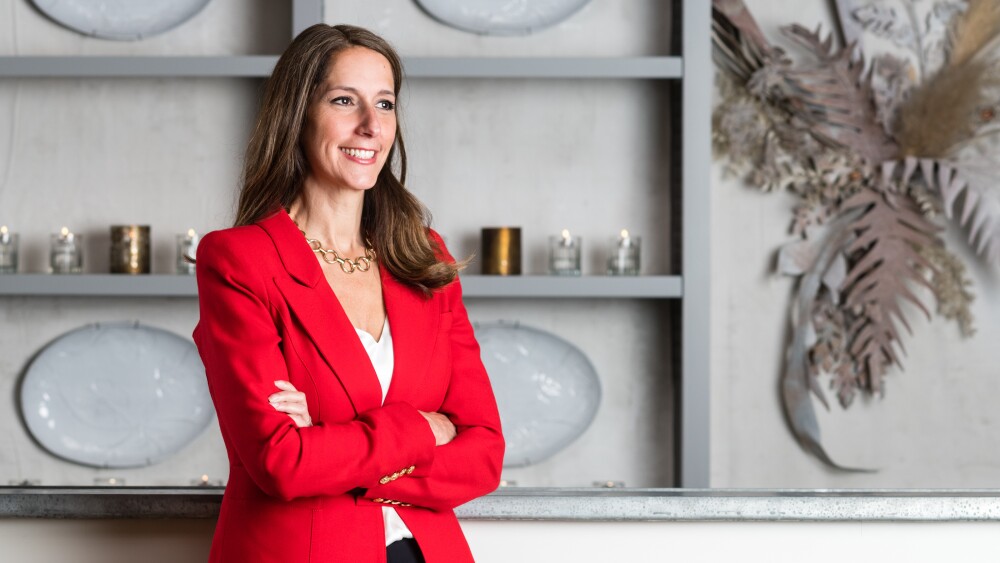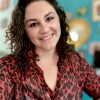From Wall Street to real estate to a “big, ugly” pharma building, Mayo Venture Partner Audrey Greenberg reflects on a career defined by taking a leap at just the right moment.
Audrey Greenberg’s career has been defined by being in the right place at the right time—and sometimes, the wrong place at the wrong time.
After bucking the family trend of practicing medicine, Greenberg pursued a career in business and was working on Wall Street on September 11, 2001. “I watched the towers fall, and I thought, what do I want to do that actually makes an impact on society, instead of just moving other people’s money around?”
An opportunity arose to start a real estate venture focused on tax credit housing, an incentive given to developers who agree to rent a certain portion of the resulting building to low-income individuals. This specific venture focused on developing battered women’s shelters and senior housing in impoverished areas.
“When you watch a building come down, and then you have the opportunity to watch something go up—theoretically, not in its place but taking up a skyline that not only provides housing, but services to people in need—that really hit me,” Greenberg told BioSpace in an interview.
From there, she went on to larger real estate ventures before meeting her husband and moving around the country until they finally landed in Philadelphia, with two kids in tow and another on the way. Greenberg spent this time serving as an interim executive at different companies, where she met someone who was working on buying one of GSK’s old buildings in King of Prussia. “It was this big, ugly, empty pharma building,” she remembers.
At the same time, her daughter was diagnosed with cholesteatoma, a slow-growing, non-cancerous tumor that occurs in the ear. Greenberg was officially pulled into the family vocation of healthcare.
Building an Ecosystem
She knew about the famous scientists of the University of Pennsylvania—Carl June, Jim Wilson and Drew Weissman—who were “essentially inventing cures,” Greenberg said. But they had a big problem: they could not get them to patients outside of their immediate orbit.
So Greenberg and her associates created a biomanufacturing hub for cell and gene therapy that combined capital sources for small companies with manufacturing, innovator companies and Big Pharma, all in one place. The contract development and manufacturing enterprise, called the Center for Breakthrough Medicines (CBM), offered plasmid DNA, viral vectors and cell processing, testing and analytical services. It was located near UPenn in Philly’s Cellicon Valley and just a short drive to an international airport, where therapies could be shipped around the world.
“It was right place, right time for the industry, for the economy and for Philadelphia and cell and gene therapy,” Greenberg said. “We created something that did not previously exist.”
What was supposed to be a hub for Philadelphia quickly grew to include international clients. “It ended up being an ecosystem for the general sub-industry within cell and gene therapy,” Greenberg said.
All the while, Greenberg got her first taste of company formation in biotech. She learned about company growth, commercial excellence and operating in a tight market. While she didn’t have previous biopharma experience, she says her most important contribution was hiring the right experts who did.
“I made sure that we had a concierge level service that really met the market where it needed to be,” Greenberg said.
She knew she would sell CBM someday from the first capital raise. She went on to oversee capital raises exceeding $500 million before the right opportunity arrived. In September 2023, the center was sold to SK Pharmteco, a California subsidiary of South Korean investment group SK Group, for an undisclosed amount.
“A lot of people come to me for advice, and I always say, start with the end in mind,” Greenberg said. “What do you want to be when you grow up, and how? What are the moves you’re going to take to get there?”
After selling CBM, Greenberg stayed on for one year to facilitate the transition. Afterward, she thought hard about her next adventure. She received at least a dozen offers from biotechs to become CEO but she wanted to do something with an even bigger impact. Then around the J.P. Morgan Healthcare Conference in 2024, the Mayo Clinic approached her with an opportunity to become partner at a new venture arm the famed hospital was starting up. It was an easy choice.
“There was an opportunity to participate in all aspects of an innovation ecosystem that always puts the patient at the top of the food chain,” Greenberg said. She officially joined two months ago.
‘Dream Big’
The process of selling CBM was, of course, not linear. It left Greenberg with plenty of lessons learned and advice to pass on. She said they had 400 versions of their PowerPoint presentation and delivered as many as 200 pitches over the course of the company’s existence. The COVID-19 pandemic also got in the way, throwing those key meetings onto Zoom and forcing the team to learn a new way to do business.
One thing Greenberg learned is that the little details matter. Taking the time to learn about the investor’s personal life and find common ground pay off in the long run, she said.
“People invest in people they feel comfortable with. You can have the story and have the pitch . . . but it’s also about the chemistry that you have with that person. Can they trust you? Are you like them in some way? Why are you better than the next person?”
She also suggests having a great rapport with your team, especially if something goes wrong. “If you have a glitch in technology, and then you freak out and start screaming at someone—which I would never do anyway, but I’ve seen this happen in other companies when someone’s pitching to me—if the two founders don’t get along, there’s no way.”
In this brutal biotech market, Greenberg said it pays to mitigate expectations and understand that investors are calculating risk and valuations much more conservatively than they have in the past. Company executives should be very mindful of how much they raise and at what valuation, she added.
Still, that shouldn’t stop you from shooting for the stars, Greenberg said. “Dream big, because you’re only going to achieve what you set out to achieve. And so if you can have very lofty goals, often you will achieve them.”






